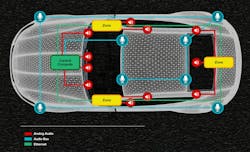From Your Living Room to the Open Road: Bringing Premium Audio to More Cars
What you’ll learn:
- The quiet of EV propulsion systems, coupled with their lightweight construction, make road noise more noticeable, necessitating the use of active noise cancellation to enhance the driving experience.
- Premium audio systems require minimized end-to-end latency of the ANC signal chain to maximize the band of noise cancellation at the human ear.
- Seat-specific audio zones require arrays of microphones and speakers for each seat, on top of even more advanced DSP algorithms.
In 1930, the Galvin Manufacturing Corp., later renamed Motorola, released the first car radio for aftermarket installation in vehicles such as the Ford Model A. At the time, the idea of electronics was almost unthinkable in a car. Not only was installation extremely difficult for what was essentially a single speaker and an AM radio, but the system alone cost nearly one-fourth the total value of the vehicle.
In the 90-plus years since then, automotive audio systems have become a standard part of every vehicle model. It’s been an interesting journey that spans transistor-based radio, the FM radio band, cassette tape and compact disc players (including an attempt at 8-inch vinyl), and now more modern-day offerings such as smartphone connectivity and satellite radio.
The common theme is that manufacturers took something the public was familiar with outside of vehicles and brought the same audio experience into vehicles. We’ve even reached a point where some car audio systems may be the best-performing audio system that a person owns.
Electrification and Automotive Audio
A lot of the change in automotive audio systems is directly related to larger architectural modifications in automobiles. Vehicle electrification greatly impacts the user’s audio experience.
While you may no longer hear the rumble of an internal combustion engine in an electric vehicle (EV), you’ll soon notice the noise of the road vibrating through the wheels into the cabin. EVs also need to be as light as possible to maximize battery range, which has reduced passive noise insulation in the doors, thinner glass for the windows, and the removal of vibration dampers in the wheels. These changes have placed the responsibility for minimizing noise onto the audio system.
In the commercial audio industry, trends include features such as active noise cancellation (ANC) in headphones and extremely efficient audio amplifiers to enable a longer listening time in portable battery-powered speakers.
A feature such as ANC can also help improve the general experience in an EV. Meanwhile, a more efficient audio amplifier in a portable speaker can translate to a more efficient audio system in an EV that has a less significant impact on the total driving range over the life of the vehicle.
ANC isn’t the only feature making its way into new cars. An immersive spatial audio experience made possible through Dolby Atmos technology can also enhance the in-vehicle audio experience. Dolby Atmos is an evolution of the well-known home theater surround-sound concept initially designed to provide more precise spatialization of music, movies, and video games to achieve a more immersive three-dimensional listening environment.
In a headset, Dolby Atmos requires specific phase and timing processing of a spatialized audio mix into a pair of speakers right next to your ear. Expanding that into a home requires as many as 12 speakers to surround listeners and provide depth, height, and the precise location of those sounds. This requires quite a bit of tuning for the environment and an extensive amount of processing of a multichannel audio source to actualize the sound experience intended by the creator.
ANC and Dolby Atmos need quite a bit of multichannel digital signal processing (DSP), and there’s even more that an audio system must handle in a modern vehicle. For example, advanced driver-assistance systems (ADAS) use audio to play informational chimes and alerts. And acoustic vehicle alerting system (AVAS) tones for EVs help compensate for the lack of engine noise so that pedestrians can hear vehicles approaching. Interior chimes and exterior AVAS tones require active monitoring of the vehicle and must provide audio information quickly.
Technical Requirements of a Premium Audio System
One of the technical challenges to address in a premium audio system involves the end-to-end latency of the ANC signal chain. Reducing latency and generating anti-noise into the cabin as fast as possible requires the optimization of every device in the signal chain. Minimizing time on the input and output enables audio DSP engineers to account for a larger band of audio noise for their noise-cancellation algorithms.
A typical ANC system needs the noise-capture to anti-noise-generation signal path (Fig. 1) to take at most 2 ms, which equates to a maximum of 500 Hz cancelled at the human ear.
Audio converters and amplifiers such as the PCM6240-Q1 and TAS6584-Q1 from Texas Instruments (TI) provide a low-latency signal path for minimal overhead in the analog portion of the signal chain. Using a low-latency path in the design helps ensure that the most time-sensitive signals get where they need to be as fast as possible. TI designed these devices to enable integrated filtering and other processing capabilities so that designers can create a full-featured and high-performance experience for vehicles’ drivers.
All of these features lean heavily on the system’s DSP, especially in terms of processing capabilities. That’s where an integrated DSP core such as the TI C7x vector DSP, found in the company’s AM2754-Q1 and AM62D-Q1 Arm Cortex-based processors, provides a cost-friendly approach to an advanced premium audio system.
The 40GFLOP C7x cores in these processors can handle dozens of individual audio sources derived from ANC sensors, local tones in memory, or music data coming from a central computing unit over Ethernet. Such high computing capability enables a more effective, and lower-latency, ANC solution on top of the immersive listening experience of Dolby Atmos.
What’s Next for Audio?
A decade after the first Ford Model A audio system, Motorola took out a newspaper ad that said, “Electronics? Sure! We’ve had it in our home for 20 years!” It’s clear that even back then, automotive audio features and solutions lagged behind.
Today, with larger vehicle trends around autonomy and robotaxis, there’s more of an opportunity for the in-cabin experience to involve less driver input. Not only will vehicles become a moving office and entertainment system—giving users even more of a reason to have a premium audio experience—but there’s interest in features that take noise cancellation to the next level, such as seat-specific audio zones that offer each passenger a unique listening environment. This feature does require arrays of microphones and speakers for each seat, on top of even more advanced DSP algorithms.
The automotive industry is also developing the next generation of vehicle networking and computing through the implementation of zone-based architectures and software-defined-vehicle (SDV) experiences. They directly impact where audio is captured, its distribution throughout the vehicle over a network (Fig. 2), and the amount of audio software flexibility and configuration available to users.
As these systems become more complex, it becomes crucial that automotive manufacturers leverage advanced semiconductors and design expertise from semiconductor suppliers like TI to stay on top of the latest and greatest in audio technology and design for the vehicle of the future.
To stay tuned to our latest and best automotive electronics articles, please subscribe to Electronic Design’s Automotive Electronics bi-weekly newsletter.
About the Author

Matt Sullivan
Systems Engineer, Infotainment Systems, Texas Instruments
Matt Sullivan is a systems engineer specializing in premium audio and automotive networking designs. Focusing on the automotive system as a whole, he investigates how TI’s products can help designers create best-in-class audio systems. This includes Class-D amplifiers, boost converter tracking power supplies, audio DSPs, Ethernet AVB, and more.
Matt received his BSEE from the University of Southern California, where he also studied music recording and production.


